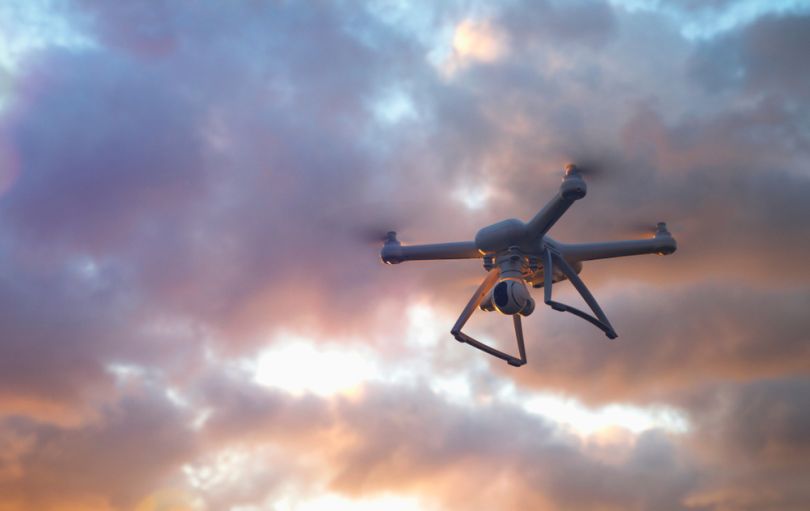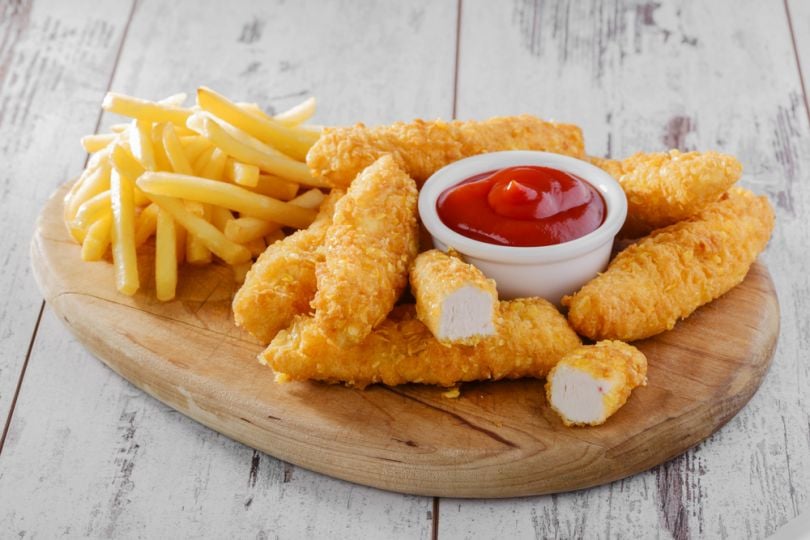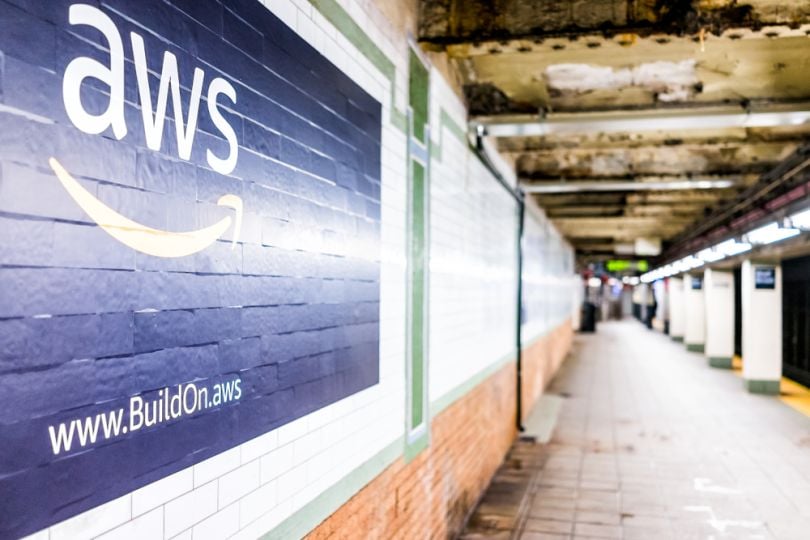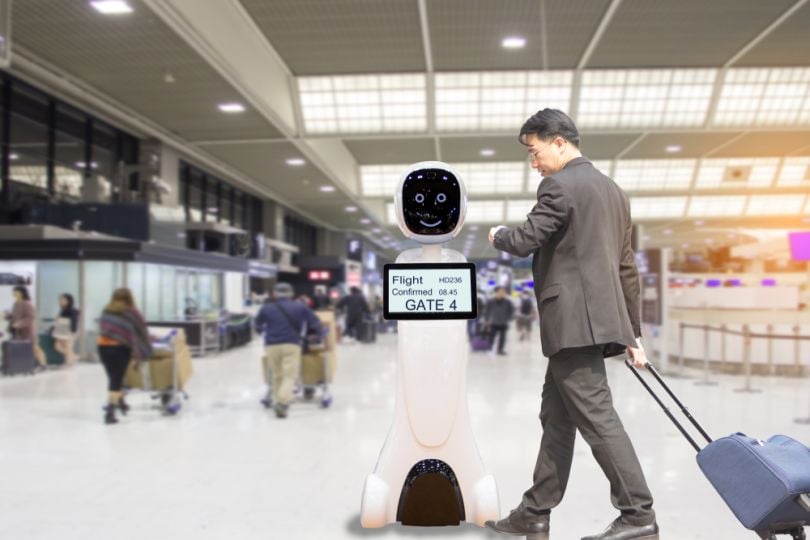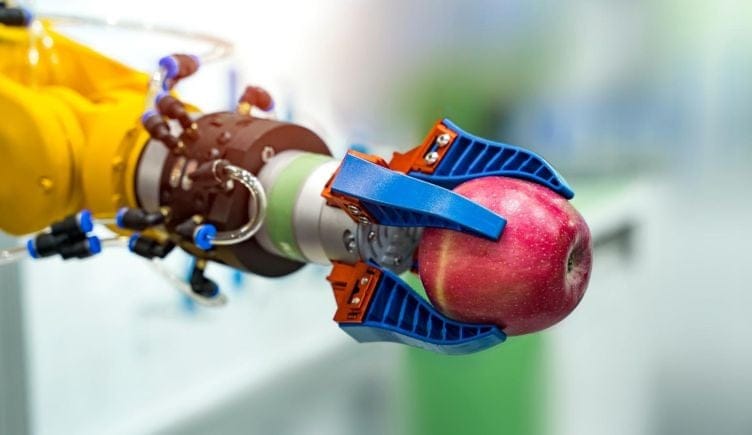 Image: Shutterstock
Image: Shutterstock
“High-tech farming” is no oxymoron. A contemporary agricultural operation is more likely to resemble Silicon Valley than American Gothic, with apps that control irrigation, GPS systems that steer tractors and RFID-chipped ear tags that monitor livestock. And agricultural robots play a key part of that technological stable.
Agricultural robots pick apples, gather strawberries, harvest lettuce and strip away weeds. Drones gather aerial images that help farmers quickly assess crop health. And robotic greenhouses are sprouting up thousands of miles away from traditional farmland regions, growing vegetables in the backyards of high-consumption urban markets.
It all comes at a time when growers face a costly, long-term labor shortage and — with the global population expected to rise from 7.7 billion to 9.7 billion by 2050 — food demand is poised to rise significantly.
Here’s how agricultural robots can help mitigate some of those challenges.
More on AgTechIs Vertical Farming the Future of Agriculture?
Agricultural Robots in Crop Harvesting
On its face, crop harvesting seems ripe for automation. It’s physically taxing and highly repetitive — the kind of labor that’s often most effectively targeted in the robot revolution. But that’s not necessarily the case.
Picking crops also requires manual dexterity and a delicate touch. Many fruits bruise easily in the heat, and leafy vegetables are easily torn. And most robots just aren’t advanced enough to handle that level of precision. But agtech companies are working to clear that hurdle.

Tortuga AgTech
Location: Denver, Colorado
Tortuga AgTech provides farms with robots that automate tasks like identifying and picking ripe fruit. The company says its solutions can help to address challenges like labor shortages and rising costs, while also avoiding any damage that might be caused by human hands during the harvesting process. A squad of the autonomous robots are able to pick fruit with 98 percent accuracy requiring only the supervision of a single person, according to Tortuga.
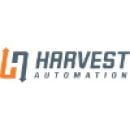
Harvest Automation
Location: Billerica, Maine
Founded by former employees of Roomba inventors iRobot, Harvest Automation made its first product with the fast-growing gardening market in mind. The behavior-based HV-100 robot handles the important, but highly repetitive and strenuous, work of spacing container crops and plants. Greenhouse plants need space between them so they grow thick and bushy and resilient, but too much space means square footage isn’t being optimized. The HV-100 is built to keep running even in the scorching temperatures and less-than-pristine environments of nurseries that grow ornamental plants and specialty fruits and veggies.

Harvest Croo
Location: Tampa, Florida
Harvest CROO is a robotics startup that has developed an advanced strawberry-harvesting robot. It uses a variety of robotic components — rather than a single arm — to grab the leaf, pick the berry and pack it. Computer vision helps Harvest CROO’s robotics system decipher ripe berries from non-ripe ones before plucking. And it’s fast compared to human laborers, purportedly able to pick a plant in eight seconds and shift to the next in one-and-a-half.

University of Cambridge
Location: Fully Remote
Lettuce harvesting has remained stubbornly robot-resistant thanks to the plant’s fragile nature and close proximity to the ground. But researchers at Cambridge University made a breakthrough with “Vegebot,” another computer vision-powered prototype.
Here’s how it works: One camera scans the lettuce and gives a thumbs up or down for harvesting. A second camera (positioned near a blade) then guides the pick without crushing the plant. Meanwhile, a machine-learning algorithm “teaches” the robot to avoid unripe or diseased lettuce.

Fresh Fruit Robotics
Location: Israel
FFRobotics is developing a robotic fruit harvester for the commercial market. The company’s robotic system uses computer vision to identify ripe fruit and emulates the motion of a human hand while picking apples. According to the company’s website, the robotic harvester is 10 times faster than human pickers. Although still in development, the company has received funding from the European Union’s Horizon research program.
Agricultural Robots in Weeding and Mowing
If you’ve ever tended a personal garden, you’re well aware that chores like mowing and weed control are both important and difficult. Commercial agriculturists know it too, but on a massive scale. Even when crop rotation is possible, many large outfits rely at least somewhat on the use of herbicides. But given the facts that plants can become resistant to weed killers and consumers are increasingly averse to chemically treated food, it’s hardly a perfect solution. And mowing is a time-consuming responsibility for large properties. That’s why weed-management and mowing robots — including ones that incorporate advanced AI — are an attractive option.

Carbon Robotics
Location: Seattle, Washington
Carbon Robotics’ LaserWeeder uses AI and computer vision to handle weed control for specialty crops. The mowers are able to differentiate between crops and weeds and then use laser technology to destroy the weeds without causing any damage to the crops. The company says its technology can improve the quality of crops while also reducing costs.

Scythe Robotics
Location: Longmont, Colorado
Scythe Robotics produces autonomous electric mowers to ensure property upkeep is efficient and sustainable. The company’s M.52 mower is equipped with a dozen sensors to enable 360-degree perception, as well as advanced artificial intelligence to allow the machine to navigate around obstacles.

Naïo Technologies
Location: Fully Remote
Naio Technologies has developed three distinct robots to do everything from assisting farmers in hoeing fields to weeding vegetable fields and wine vineyards. One notable example is the company’s partnership with Château Mouton-Rothschild to enlist Ted, the company’s vine-tailored robotic weed killer, in their vineyards.
Electric and shaped like an inverted U, the long-running Ted simultaneously rolls over and around a vine row, using RTK satellite navigation to stay on course with the help of drones to map out the initial plot of land that Ted surveys. Industry-standard blades and finger weeders run along the base, pulling unwanted weeds from the vines and consequently decreasing the need for herbicides.

Nexus Robotics
Location: Fully Remote
Nexus Robotics has created a weed-yanking autonomous robot dubbed R2Weed2 (yep, you read that correctly), that employs artificial intelligence to differentiate between weeds and crops so the former are stripped and the latter left to grow. As it runs, R2 also gathers data that help farmers with soil analysis and environmental monitoring.
Read Next41 Robotics Companies and Startups on the Forefront of Innovation
Agricultural Robots in Greenhouses
Instead of bringing agricultural robots to the field, one of the next great advances in farming automation will bring the field to robots.
There are several startups helping to plant the seed for a robotic-greenhouse future. Not everything is growable in this way, but for certain crops the improvements are striking. These companies promise a dramatic decrease in the amount of water used — between 90 and 95 percent less — for an equivalent crop yield, and boast controlled indoor environments that eliminate the need for pesticides.

AppHarvest
Location: Burlington, Massachusetts
AppHarvest is an indoor farm company using AI and robotics as well as rainwater collection and precision growing to reduce water consumption and increase crop yields. Located in Central Appalachia, the company aims to produce sustainable produce that can be shipped to 70 percent of the country’s population within a day. Its use of robotics allows for optimized indoor environments and plant monitoring.

Iron Ox
Location: San Carlos, California
Inside what Iron Ox describes as “the world’s first autonomous farm” — an 8,000-square-foot space that more closely resembles a research lab than a farm field — two cloud-connected robots oversee the growth of leafy greens like romaine and butterhead lettuce, bok choy, kale and arugula as well as a variety of herbs. All the produce is grown inside heavy hydroponic pods. Using computer vision and sensors as its “eyes,” one robot does the heavy lifting, transporting the pods across the facility; the second analyzes and picks the individual plants. It all happens beneath high-efficiency LED lights and under the watchful eyes of some dozen on-site robot and plant scientists.
Iron Ox began production in its hometown San Carlos, Texas and the company’s products are now available in several states in the West and Southern regions of the country.

Bowery Farming
Location: New York, New York
Bowery Farming stacks up layers of trays, each filled with greens, in the traditional vertical-farming format inside its East Coast farms. The company is using robotics, artificial intelligence and LEDs to grow leafy greens and herbs with the goal to address problems posed by labor scarcity, population booms and centralized farming.
At Bowery Farming facilities, a proprietary operating system and complex array of sensors collect data and maintain an ultra-precise balance of water, temperature, nutrients and humidity. At the same time, a team of vertical farmers help to harvest and watch over the crops. The company sells its greens and herbs at Whole Foods, Foragers and Westside Market. In the New York metro area, they’re also available through Peapod, Jet.com and Amazon.
Aerial Imagery Drones and Seed-Planting Drones
Aerial imagery can save farmers a lot of time by giving them a bird’s eye view of crops. This way, they can quickly get a sense of vegetation’s health, insect issues, irrigation layouts and weed growth. It even allows them to precisely determine how much pesticide the crops require.
Farmers can use a variety of subscription services to access these valuable flyover images — thermal, infrared and NDVI for instance — of their fields, but fewer companies have taken the full plunge into unmanned aerial vehicles. That’s most likely because of FAA restrictions on autonomous drones, which require that pilots be immediately ready to take control of a drone. Small unmanned aircrafts must also be kept within a would-be pilot’s line of sight when airborne.
But they’re out there. Here are some companies that prove there’s something’s in the air when it comes to agricultural imaging, seed planting and cloud seeding.

American Robotics
Location: Waltham, Massachusetts
One of several companies making notable agtech breakthroughs, American Robotics is the team behind Scout, an aerial imaging drone that fits the so-called “drone in a box” model.
Between flights, Scout lives inside a weatherproofed box, where it self-charges and processes via edge computing all the data it collects. When it takes flight to examine fields, the box top opens and the fully autonomous drone lifts off, using artificial intelligence to plot and conduct the run. During missions, which can be scheduled or launched on demand, Scout gathers crop stress data that farmers can use throughout a crop’s life cycle.

UAV Systems International
Location: Las Vegas, Nevada
Any UAV pilot who wants to fly a drone that weighs more than 55 pounds at takeoff needs to petition for a special exemption through the FAA. That means non-exempt farmers who want to drone-scatter seeds over their acreage are limited in how many pounds of seed they can spread in a single run. Still, a number of manufacturers have developed drones marketed specifically for that purpose.
UAV Systems International sells two drones that spread seed and fertilizer, one with a payload capacity of about four pounds and another with a roughly 11-pound payload. Both have a two-mile flight range and a 20-minute limit, according to the company. UAV also offers crop sprayer drones and surveillance drones that inspect crop health.
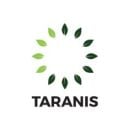
Taranis
Location: Westfield, Indiana
Given the FAA’s restrictions on autonomous drones, perhaps it’s no surprise that some of the leading purveyors of agriculture-focused UAVs cater to an international clientele. That includes Taranis, which has brought its high-resolution scans to farmers in Europe, South America and North America. Along with more traditional aircraft, the company operates drones that use computer vision and data science to monitor crop stress and self-improve identification capabilities.
Location: Reno, Nevada
Cloud seeding is all about making it rain — literally. The concept dates back to at least 1946, when Dr. Bernard Vonnegut discovered that, under certain conditions, introducing silver iodide particles to clouds could spur the creation of ice crystals, potentially precipitating precipitation. Although there have been some doubts with the concept, as droughts worsen, government agencies keep trying. In 2017, the Desert Research Institute, in conjunction with Drone America, notably launched an unmanned cloud-seeding drone during an hourlong autonomous flight and beyond researchers’ naked line of sight. Since then, the institute has developed a program that regularly conducts cloud seeding research in various mountain ranges in the Western regions of the United States.
If the website content violates your rights, please contact us to delete it。



